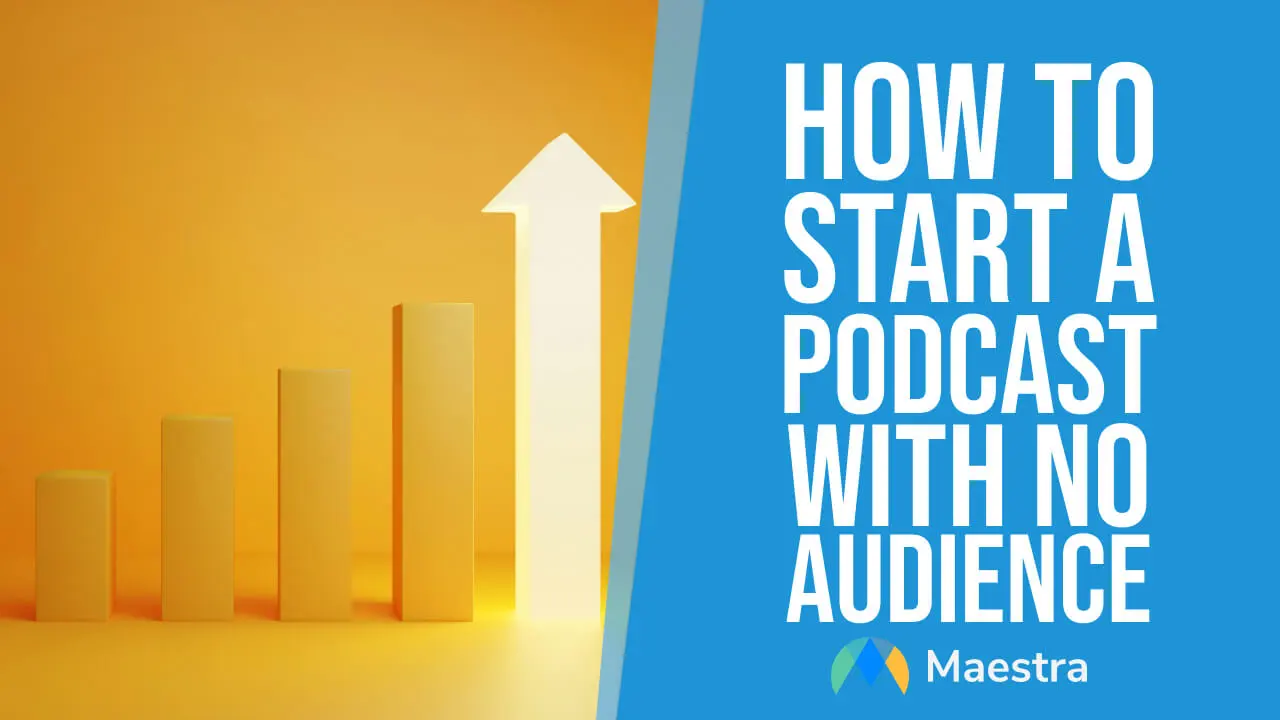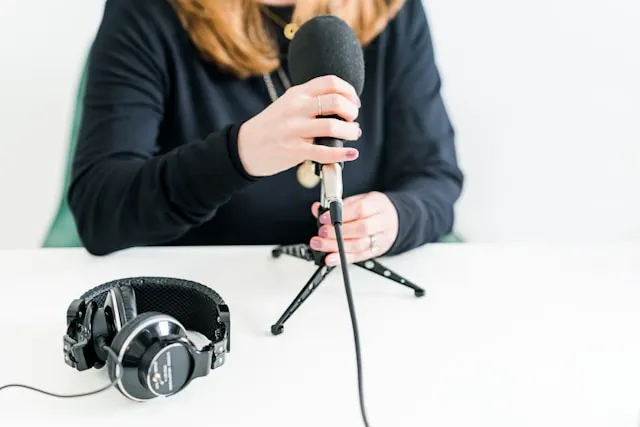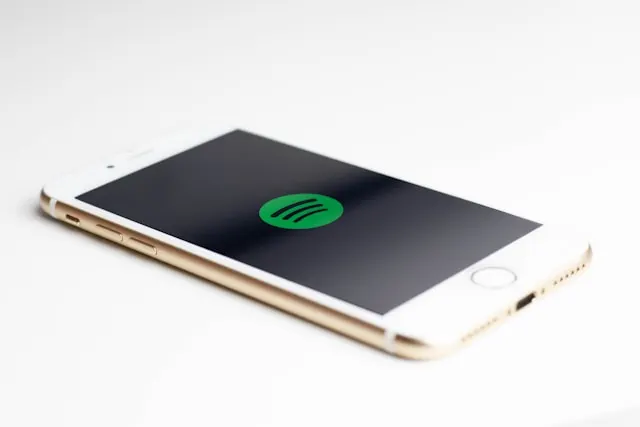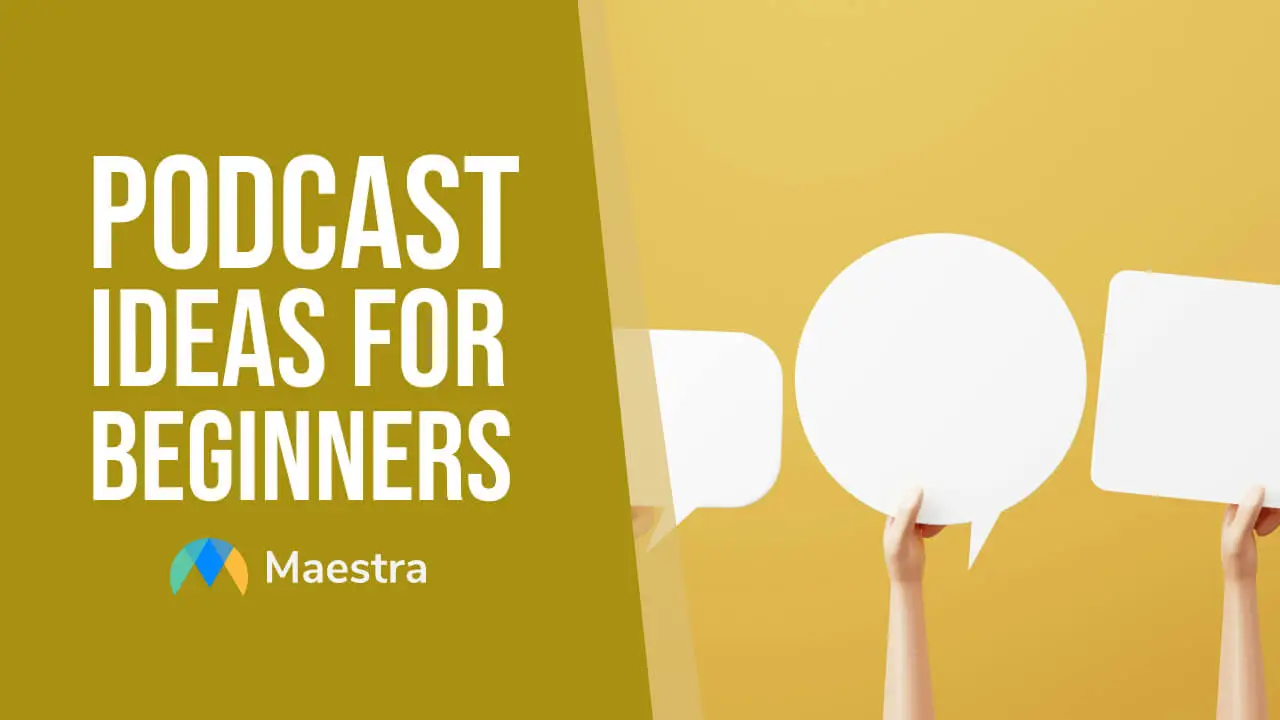How to Start a Podcast with No Audience in 3 Stages

Wanting to start a podcast but fearing no one will tune in? Many aspiring podcasters worry that their episodes will go unheard, leaving them feeling vulnerable and disheartened. Yet, it’s possible to turn that uncertainty into future success by employing certain strategies and best practices.
In this blog, we will:
- List what you need as a beginner to start a podcast
- Guide you through how to start a podcast with no audience in three stages
- Share common obstacles creators face when starting a podcast and how to overcome them
Let’s get started.
Can you start a podcast without a following?
Yes, you can definitely start a podcast without a pre-existing following. Just like any journey begins with a single step, podcasting is about gradually building an audience.

Keep in mind that this process requires patience, consistency, and strategic promotion. Another crucial aspect is originality, as unique and authentic content will help you stand out in a crowded space. Stay true to yourself while providing value to your audience. Over time, your audience will grow as you continue to refine your approach and connect with people who appreciate your content.
What do you need to start a podcast?
Before we explore how to start a podcast with no audience, let’s go over the essentials. You don’t need anything super fancy as a beginner; instead, focus on the basics that will help you create quality content and establish your brand. Here’s a list of must-have items and a guiding philosophy to kickstart your podcasting journey:
- Growth mindset, as improvement comes over time
- Smartphone or tablet with free podcasting apps (such as Spotify for Podcasters or Podbean) for recording, or a USB microphone
- Headphones for monitoring audio and isolating sound
- Free editing software like Audacity
- A quiet space away from distractions and background noise
*If you have the budget, consider investing in paid recording and editing software for advanced features and functionality. Popular options include Adobe Audition and Reaper.
*For advanced soundproofing, you can buy soundproofing panels, carpets, or acoustic forms to minimize echo and background noise.

How to Start a Podcast with No Audience in 3 Stages
Launching a podcast without an existing audience can seem daunting. This guide will take you through three key stages: laying the foundation, building the columns, and growing your garden. Each stage is designed to equip you with the tools and knowledge on how to start a podcast with no audience.
Lay the Foundation
When creating a podcast, the first step is to lay a solid foundation. Think of these practices as the cement that holds your podcast together:
- Decide on your niche. This must be an area you’re passionate about and knowledgeable in, but also where there’s a demand for that content. It can be tricky to find the right balance between your interests and market viability, so try to identify gaps and unique angles you can explore. (More on that in the next section.)
- Research the preferences of your target audience. Explore similar podcasts, read listener reviews, and engage with online communities in your niche. This will help you fine-tune your podcast’s episode topics, format and tone to meet the target audience’s expectations.
- Choose a podcast hosting platform. A hosting platform stores your audio files and distributes your episodes to major podcast directories like Spotify and Apple Podcasts. (Popular options include Buzzsprout and Podbean.)Consider your budget as well as the platform’s storage capacity and ease of use when making your decision.
- Select the equipment you’re going to use. While you don’t need to invest in top-quality gear immediately, aim for equipment that provides good sound quality. You can use your smartphone to record episodes, but it will be even better to use an external microphone for clearer audio.
- Craft the right podcast name. It should be catchy, memorable, and reflect the content of your show. Make sure the name isn’t too long or difficult to pronounce, and check for available domain names and social media handles to prevent any potential branding issues.
- Write an effective podcast description. Clearly explain what your podcast is about, who it’s for, and what value will listeners get from it. Keep it concise, and use keywords that can improve your discoverability on podcast directories and search engines.

Build the Columns
With a solid foundation in place, it’s time to raise the columns that will form your podcast. Consistent, high-quality content will strengthen your podcast from the ground up and support long-term growth.
- Have consistent branding. First things first; a cohesive brand across all podcast materials will help you create a strong brand identity and make people remember your show. Use consistent colors, fonts, and messaging to build recognition and trust among your first listeners.
- Add your show to podcast directories. Submit your podcast to major directories like Spotify and Apple Podcasts to increase its visibility. Each platform has its own submission guidelines, so follow them closely for a smooth process.
- Create a trailer. A well-crafted podcast trailer can be a powerful tool for attracting your first listeners. Keep it short but engaging, highlighting the value of your podcast and the unique aspects that set it apart from other shows.
- Record with high audio quality. People are more likely to listen to a podcast that sounds crisp and professional. If you’re on a budget, you can start with a decent USB microphone that won’t break the bank, and record in a quiet space to minimize background noise. For those with greater resources, investing in an XLR dynamic microphone and using soundproofing materials in your recording area can significantly enhance the overall audio quality.
- Edit the recording meticulously. Remove any long pauses, filler words, or irrelevant content that may disrupt the episode. Use editing software to adjust audio levels, add music, or incorporate sound effects where appropriate.
- Include a call-to-action (CTA) in each episode. This will guide your listeners on what to do next, whether it’s subscribing, following you on social media platforms, or visiting your website. Just integrate it naturally into the beginning or end of your episode so it does not feel forced and disrupt the flow of the content.
- Design attention-grabbing cover art. Your podcast cover art is the first impression potential listeners will have, so it should be visually striking and reflective of your show’s theme. Use bold colors and clear typography, making sure it meets the specific requirements by podcast directories for optimal display.
- Write episode descriptions carefully. Convey what listeners can expect from the episode, including key topics and guest appearances if there are any. Incorporating relevant keywords can also improve the podcast’s searchability in podcast directories.
- Transcribe your episodes with AI. This crucial practice can make your podcast accessible to a wider audience, including individuals with hearing impairments or those who prefer to consume content in text format. Transcripts also improve your podcast’s SEO performance, and can be repurposed into social media snippets or email newsletters.
Transcribe Your Podcast in 125+ Languages
Grow Your Garden
As your podcast begins to take root, the next big step is growing your audience. By focusing on community-building and meaningful engagement, you can cultivate a loyal listener base.
- Have dedicated social media accounts for your podcast. Post updates on new episodes, share behind-the-scenes moments, and interact directly with your listeners as you build your audience over time. Having specific accounts will also boost brand consistency, allowing you to maintain a focused messaging style and aesthetics.
- Utilize email marketing. This can be challenging at first without an audience, but you can offer something valuable in exchange for email sign-ups. It could be a free downloadable resource, exclusive content, or early access to episodes. After building your subscribers list, engage with your audience by sending regular updates about new releases, or tips related to your podcast’s niche.
- Try paid advertising .If you have a budget, paid ads on platforms like Instagram or Google can attract new listeners. Target specific audiences that align with your podcast’s niche to get the most out of your investment.
- Build a passionate community. Platforms like Discord allow for real-time interaction, where you can discuss episodes and cultivate meaningful relationships with your audience. As your community grows, these dedicated listeners can become advocates for your show, spread the word, and bring new followers organically.
- Partner with other podcasters. Consider reaching out to creators in similar niches or those who complement your content. Exchange guest appearances on each other’s shows or even create joint marketing campaigns.

Discord is a powerful platform for community building.
Starting a Podcast: Common Obstacles and Solutions
As with any creative endeavor, starting a podcast (especially without an established audience) comes with its own challenges. Here are some of the most common obstacles beginner podcasters face and actionable solutions to overcome them.
| Problem | Solution | Actionable Tips |
| Finding the right niche | List your interests and then research the market. | -Write down your passions and expertise.
-Analyze existing podcasts in those areas for gaps to fill. -Use online tools like Google Trends to check niche popularity. |
| Securing quality podcast equipment on a budget | Start with basic, affordable gear. | -Use your smartphone or a USB microphone for recording.
-Explore second-hand options for audio equipment. -Consider recording in a small room with soft furnishings to enhance sound quality. |
| Coming up with engaging and original episode ideas | Brainstorm and gather inspiration from various sources. | -Try mind mapping to visualize episode ideas and connections.
-Keep a journal of ideas and themes that resonate with you. -Attend industry events or ask for suggestions from potential listeners. |
| Overcoming self-doubt | Focus on personal growth and community support. | -Start slowly; set realistic goals and celebrate small achievements.
-Listen to motivational content that inspires confidence. -Focus on the value you provide rather than perfection. |
| Networking for marketing and promotion | Build relationships with other podcasters. | -Engage on social media by commenting on or sharing others’ content.
-Participate in relevant online communities to share knowledge. -Utilize LinkedIn, Twitter, Facebook groups or Instagram to connect with industry professionals and seek advice or mentorship. |
Frequently Asked Questions
Can a solo podcast be successful?
Yes, a solo podcast can definitely be successful, particularly if the host has a unique voice and well-organized content. The show will especially draw listeners if the host maintains a strong connection while delivering value to the audience. Adding personal anecdotes or experiences can make the content feel more relatable and authentic.
What makes a good podcast?
A good podcast offers a fresh perspective or unique approach to the chosen topic. The host(s) show genuine enthusiasm and interest for the topic, which will be contagious among listeners. Another critical aspect of a good podcast is high-quality audio and a consistent episode structure. When listeners know what to expect in terms of format, they are more likely to tune in regularly.
What is the best podcasting platform?
There is no single best podcasting platform. However, the most popular ones are Spotify, Apple Podcasts, Buzzsprout, and Podbean. When choosing a podcasting platform, make sure you prioritize features, pricing, distribution reach, user interface, and ease of integration with other tools.
How do I fund my podcast?
If you’re wondering how to start a podcast with no audience and no money, first focus on using free tools like Audacity for recording and editing. As you grow your listener base, consider utilizing crowdfunding platforms like Patreon to gain financial support. You can also approach sponsors once your podcast gains some traction.
How long does it take before a podcast is profitable?
This depends on several factors, including the podcast’s niche, marketing efforts, and audience growth rate. Typically, it can take anywhere from a few months to a couple of years for a podcast to become profitable. A strong connection with the audience and effective monetization strategies can speed up the process.
Summary
This blog covered how to start a podcast with no audience in three stages: laying the foundation, building your podcast’s brand with high-quality content, and growing your audience through strategic engagement and promotion. It also highlighted common obstacles faced by new podcasters, and provided actionable solutions to overcome them.
Here are our 3 golden rules for starting a podcast with no audience:
- Adopt a growth mindset by embracing challenges with resilience and patience, as improvement comes over time.
- Invest time in creating catchy cover art and a memorable podcast name while maintaining consistent branding to enhance recognition.
- Utilize a multichannel approach by actively engaging with your audience on other platforms like Instagram, TikTok, and Discord.
Remember; every successful podcast started somewhere, often with no audience at all.


